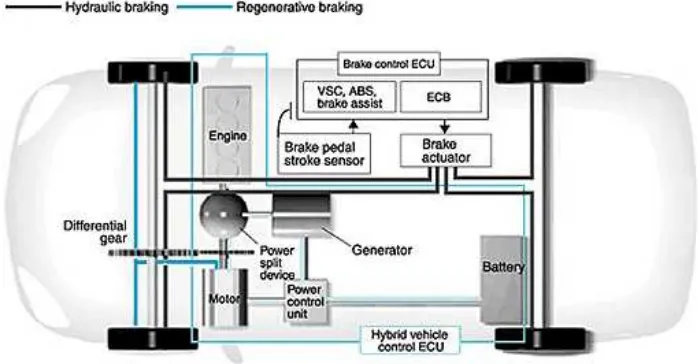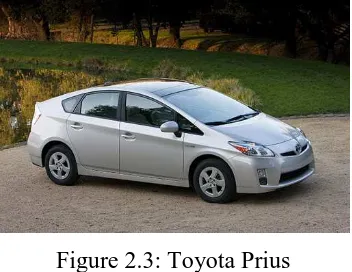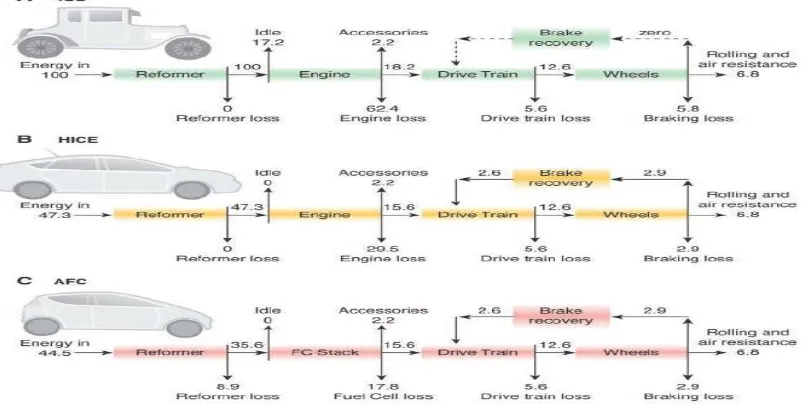Regenerative Braking System (RBS): Energy Measurement
LOI WEI CHEONG
This report submitted in partial fulfillment of the requirements for the award of a Bachelor Degree in Mechanical Engineering (Automotive)
Mechanical Engineering Faculty University Technical Malaysia Melaka
SUPERVISORS DECLARATION
I hereby declare that I have read this report and in my opinion this report is sufficient in term of scope and quality for the award of the degree of Bachelor of Mechanical
Engineering (Automotive)
Signature :
1ST Supervisor : DR.MUSTHAFAH BIN MOHD TAHIR
ii
DECLARATION
I hereby declare that the work in this report is my own except for summaries and quotations which have been duly acknowledged.
Signature :
Author : LOI WEI CHEONG
iii
DEDICATION
To my parents, who have never failed to give me financial and moral support, for fulfilling my need during the time of developing myself and for teaching me that
iv
ACKNOWLEDGEMENT
First and foremost, I would like to thank my supervisor of this project, Dr.Musthafah Bin Mohd Tahir for his valuable guidance and advice. He inspired me greatly to work on this project. His willingness to motivate and spend his valuable time for me is the biggest contributions to my project. I would also like to thank him for providing me some basic information related to my topic at the very beginning of this project.
Besides, I would like to thank University Technical Malaysia Melaka (UTeM) for providing me a good environment and great facilities to conduct my PSM 1. Addition, I would like to thank to the Faculty of Mechanical Engineering (FKM) for their guidance, starting from PSM 1 subject registration until the final presentation of my PSM. A special thank to my presentation panels, Dr. Noreffendy and En. Faizul for their attending and judging, and provide me some important information regarding to this project.
v
ABSTRACT
vi
ABSTRAK
vii
CONTENTS
CHAPTER TITLE PAGES
DECLARATION ii
DEDICATION iii
ACKNOWLEDGEMENT iv
ABSTRACT v
ABSTRAK vi
CONTENTS vii
LIST OF TABLES xi
LIST OF FIGURES xii
LIST OF SYMBOLS xiv
LIST OF ABBREVIATION xv
LIST OF APPENDIX xvi
CHAPTER I INTRODUCTION 1
1.1 Project Introduction 1
1.2 Background 2
1.3 Objective 3
1.4 Scope 3
1.5 Problem Statement 3
CHAPTER II LITERATURE REVIEW 5
2.1 Introduction of Regenerative Braking
System (RBS) 5
2.2 RBS as Future Solution 7
2.3 Energy Efficiency for RBS 8
viii
CHAPTER TITLE PAGES
2.5 Energy Storage System 11
2.6 How RBS Works 12
2.7 Fuel Economy 13
2.8 Maximize Energy Recovery in RBS 13 2.9 Effect Of RBS On The Stability Of The
Vehicle 14
2.10 Main components in RBS 14
2.11 Alternator 21
2.12 Voltage Rectifier 23
2.13 Voltage Regulator 25
CHAPTER III METHODOLOGY 27
3.1 Project Overview 27
3.2 Project General Flow 27
3.3 Gantt Chart for PSM 1 & 2 29
3.4 Stage 1: Research Method 30
3.5 Stage 2: Prototype Design Stage
(Identifying Components) 31
3.6 Stage 3 Components Selection 33
3.7 Stage 4: Components Purchasing 37
3.8 Stage 5: Components Installation 38
3.9 Stage 6: Engineering Drawing 44
3.10 Stage 7: Model Testing and Analyzing 49
CHAPTER IV RESULTS 54
4.1 CAD Drawing 54
4.2 Items Purchasing 55
4.3 Model build-up 58
4.4 Functional Testing and Analysis 60
ix
CHAPTER VI CONCLUSION AND RECOMMENDATION 67
REFERENCES 70
x
LIST OF TABLES
NO. TITLE PAGES
2.1 Comparison between conventional, series hybrid, parallel hybrid and fuel cell
vehicle. ... 7
2.2 Input and output vehicle parameters obtained from NREL’s ADVISOR simulations. ... 9
2.3 Working principle of Electric Motor (EM) ... 16
2.4 Comparison between large electrolytic capacitor, Ultracapacitor paralleled with electrolytic capacitor and DC/DC controlled ultracapacitor module. .... 20
3.1 Gantt chart for PSM 1 ... 29
3.2 Gantt chart for PSM 2 ... 29
3.3 Type of classification of alternator ... 34
3.4 Comparison of batteries ... 35
3.5 Purchased Items ... 39
3.6 Example of functions used to develop 3D product in CATIA ... 48
3.7 Testing apparatus ... 50
4.1 Parts drawing ... 54
4.2 Total spending for the project ... 57
4.3 Model before and after installation ... 58
4.4 Unit converts ... 62
xi
LIST OF FIGURES
NO. TITLE PAGES
1.1 24V generator (previous work) 2
1.2 12V alternator (current work) 2
2.1 Regenerative Braking System (RBS) ... 5
2.2 Energy conversion in RBS ... 6
2.3 Toyota Prius ... 6
2.4 Honda Insight ... 7
2.5 Energy flow for various vehicle configurations. ... 8
2.6 Series regenerative braking ... 10
2.7 Parallel regenerative braking... 10
2.8 Toyota Prius battery ... 11
2.9 Honda Insight battery ... 11
2.10 Flywheel storage system (KERS) ... 12
2.11 Regenerative Braking System (RBS) ... 12
2.12 Configuration of series hybrid electric vehicle ... 15
2.13 Configuration of parallel hybrid vehicle ... 15
2.14 Toyota Prius inverter ... 17
2.15 Honda Insight inverter... 18
2.16 ZEBRA battery... 19
2.17 Stator ... 22
2.18 Rotor ... 22
2.19 Diode ... 22
2.20 Voltage rectifier ... 24
2.21 Voltage regulator ... 26
3.1 Flow chart ... 28
xii
3.3 Alternator ... 32
3.4 Switch ... 32
3.5 Battery ... 32
3.6 Regenerative braking layout structures ... 33
3.7 Components layout ... 38
3.8 Second hand 12V battery ... 38
3.9 Tools needed ... 41
3.10 Install primary support ... 41
3.11 Install secondary support... 42
3.12 Install alternator ... 42
3.13 Install push-off switch ... 43
3.14 Wiring the system ... 43
3.15 24V generator ... 45
3.16 Front light ... 46
3.17 Controller ... 46
3.18 Regenerative brake handle ... 46
3.19 12V alternator... 47
3.20 Constraint ... 47
3.21 Voltage output measurement using multi-meter ... 51
3.22 Testing method for 24V generator ... 52
3.23 Testing method for 12V alternator ... 53
4.1 Purchase items location ... 57
4.2 Result for 12V alternator ... 60
xiii
LIST OF SYMBOLS
Freg = Regenerative braking Force
TEM_reg = EM available regenerative braking torque
TEM_max = EM maximum generation
TUC_max = Capacitor charging capacities
�t = Transmission efficiency
r = Wheel radius
ωb = Weight factor
ω1 = Weight factor of ultracapacitor ω2 = Weight factor of vehicle velocity ω3 = Weight factor of Electric motor state
PGe_max = EM maximum generation power
PCh_max = Ultracapacitor maximum charging power
n2 = Motor rotational speed
i = Gear ratio
i0 = Final reduction gear ratio
P = Power
xiv
LIST OF ABBREVIATION
AC = Alternating current
BCU = Brake control unit CAD = Computer aided design
DC = Direct current
DOF = Degree of freedom
EECB = Emulated Engine Compression Braking EHB = Electro hydraulic braking
EM = Electric motor
EPA = Environmental Protection Agencies
EV = Electric vehicle
FLC = Fuzzy logic control
HEV = Hybrid electric vehicle
ICE = Internal combustion engine
IM = Inductive motor
KERS = Kinetic Energy Recovery System PHEV = Parallel hybrid electric vehicle
PM = Permanent magnet motor
RBS = Regenerative Braking System
RESS = Rechargeable Energy Storage System RTD = Regenerative Torque Distribution RTO = Regenerative Torque Optimization SHEV = Series hybrid electric vehicle
SOC = State of charge
xv
LIST OF APPENDIX
NO. TITLE PAGES
A Gantt chart for PSM 1 ... 78
B Gantt chart for PSM 2 ... 78
C Series hybrid ... 79
D Parallel hybrid ... 79
E Series-parallel hybrid ... 79
F Right view for model ... 80
1
CHAPTER I
INTRODUCTION
1.1 Project Introduction
The subject of Final Year Project (PSM), BMCU 4973 and BMCU 4983 are a research and related scientific fields of study at the Faculty of Mechanical Engineering (FKM) that must be provided by final year students to fulfill the requirement of award of degree. Under this subject, every student will be supervised by a lecturer and doing research regarded to the topic he or she has chosen. At the end of the semester/year, students have to carry out a presentation regarded to this project, and showing out all the result and findings of his research.
2
1.2 Background
Regenerative Braking System (RBS) in vehicle is my PSM title. My supervisor is Dr. Musthafah bin Mohd Tahir. As we know, RBS is not new technologies that exist at present. RBS was first used in the locomotive industry. Due to the lack of sophisticated technological knowledge on suitable battery power storage, therefore RBS attracted less interest and further study of this system is also suspended. Nowadays, pollution problems and the limited fuel resources for vehicles have made the RBS back to become an important system for future vehicles. RBS can reduce air pollution and fuel consumption. After understanding the importance of this RBS, which is the purpose of my PSM project will produce an RBS model for future studies. In general, RBS is a system that can recuperate mechanical energy to electrical energy during braking action. This system allows the vehicle kinetic energy to be converted into electrical energy and be storage in the power storage system. This saved energy will be used again to move the vehicle.
My final objective is to compare between DC motor and alternator which can recuperate highest energy during braking action. So, a DC motor and alternator will be assembled in the front tire of bicycle. The DC motor type is already been done by the previous student. Hence, this project will start by collecting information from literature review and then the installation of the alternator in the front tire of the bicycle. Figure 1.1 and 1.2 show the previous work and current work.
Figure 1.1: 24V generator (previous work)
3
1.3 Objective
The objectives of this PSM are:
1. To study the basic design of some regenerative braking system used in the vehicles. 2. To measure the regenerative braking energy for 24V DC motor.
3. To measure the regenerative braking energy for 12V alternator.
4. To compare the results of regenerative braking energy for 24V DC motor and 12V alternator.
5. To evaluate an efficient system for future study.
1.4 Scope
The scopes of this PSM are covering:
1. Literature review and existing design information gathering. 2. Model making using 12V vehicle alternator.
3. Build a regenerative braking circuit for 12V alternator. 4. Draw the regenerative braking components using CATIA. 5. Do off road test to the 24V generator and 12V alternator.
1.5 Problem Statement
At the 21th century, the automotive industry has post a great challenge in order to reduce the vehicle fuel consumption and emission, these is due to the shortage of fuel resources and worsen air pollution problem. According to figures released by the US Environmental Protection Agency (EPA), conventional ICE vehicles currently contribute 40-50% of ozone, 80-90% of carbon monoxide, and 50-60% of air toxins found in urban areas.
4
problems, as it recovered wasted energy and restored to become another form of useful energy. Although we realize the beneficial and positive effect bring by Regenerative Braking System, but it still has its issue or problem to be solved; one of the major problems is regarded as the suitable battery to be used in this type of vehicle. Today, most Hybrid car batteries are one of these two types:
1. Nickel metal hydride 2. Lithium ion
5
CHAPTER II
LITERATURE REVIEW
2.1 Introduction of Regenerative Braking System (RBS)
Figure 2.1: Regenerative Braking System (RBS) (Source: www.brighthub.com)
6
conventional brake is applied. The recuperate energy is then been saved in a power storage for future usage.
In RBS, the DC motor is used as a generator to recover kinetic energy from the wheel of the vehicle into electrical energy. The conventional hydraulic brake will continue to be used as an emergency brake. Because the RBS is only able to stop the vehicle in a relatively long distance and time. This situation would cause accident to occur. The RBS efficiently reduces the waste energy and regenerate energy during braking as shown in Figure 2.2.
Figure 2.2: Energy conversion in RBS
Nowadays, many modern hybrid and electric vehicles use this Regenerative Braking System (RBS). Examples include the hybrids such as Toyota Prius (Figure 2.3) Honda Insight (Figure 2.4), and the Vectrix electric maxi-scooter.
Figure 2.3: Toyota Prius (Source: www.fastmotoring.com) Kinetic energy /waste
energy from wheel
7
Figure 2.4: Honda Insight (Source: www.en.automobile.de)
2.2 RBS as Future Solution
The need to increase environmental protection and energy conservation has brought a big challenge for the automotive industry to reduce vehicle emissions and. fuel consumption. For this purpose, extensive solutions for alternative power train has been proposed, including hybrid technology is regarded as the best. Government regulations around the world have become more stringent, requiring lower production for the car (Especially U.S. EPA Tier 2 Bin 5, followed by a Euro 5).
In 2003, a research has been done by V. Dawood and A. Emadi in order to compare between fuel cell, parallel & series hybrid electric and conventional transit bus. ADVISOR software was used to simulate the various heavy-duty buses. Results show a magnificent (as indicated in Table 2.1) improvement in the fuel economy especially in the parallel configuration. [9]
Table 2.1: Comparison between conventional, series hybrid, parallel hybrid and fuel cell vehicle.
(Source: V. Dawood. 2003)
Conventional Series Fuel cell Parallel Fuel
Converter(kW)
350 100 200 150
Energy storage(kW)
8
Motor(kW) - 300 250 200
Total propulsion power( kW)
350 300 250 350
Fuel Economy(mpg)/
(km/kg)
5.1 / 0.0082 7.4 / 0.0119 7.5 / 0.0121 9.3 / 0.0149
60 mph (s) or 0-96.6 km/h
25.7 18.2 19.1 18.0
Grade Ability (%)
6.0 2.5 2.3 2.5
Max. speed (km/h)
138.4 138.9 138.7 138.1
2.3 Energy Efficiency for RBS
Demirdven, N. and Deutch, J. (2003) compare the energy efficiency of conventional internal combustion engines, fuel cell and hybrid vehicles. In their analysis (as indicated in Figure 2.5 and Table 2.2) indicates that fuel cell vehicles using hydrogen from fossil fuels offer no significant energy efficiency advantage over hybrid vehicles operating in an urban drive cycle. They conclude that priority should be placed on hybrid vehicles by industry and government.[32]



